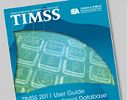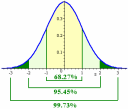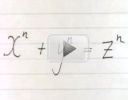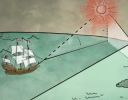IntMath Newsletter: Good math teachers, writeLaTeX, TIMSS
By Murray Bourne, 30 Jul 2013
30 Jul 2013
In this Newsletter:
1. What makes a good math teacher?
2. Resource: WriteLaTeX
3. TIMSS summary
4. Math puzzles
5. Friday math movies
6. Final thought: Procrastination
1. What makes a good math teacher?
As part of my job as a teacher trainer, I observe a lot of classes. Some teachers have obviously got what it takes, and some have a way to go in honing their skills.
In Defining Teaching Effectiveness, Maryellen Weimar lists several qualities a teacher should develop in order to be effective. She consolidates research findings from several studies, and concludes a good teacher is one who:
- Motivates students to learn by making the subject interesting;
- Is knowledgeable;
- Presents the material clearly;
- Is approachable and helpful;
- Is available to students;
- Is intellectually challenging;
- Cultivates thinking skills;
- Sets high standards; and
- Encourages self-initiated learning.
It's a good list, but I feel it is missing a few crucial elements.
- While the list includes "approachable", that's not the same as the rapport a good teacher needs to have with students. Rapport is the 2-way relationship that ensures students and teachers feel connected to each other and to the learning task. The social context in which learning takes place has a big impact on learning effectiveness. I've walked into too many classrooms where the teacher doesn't even greet the students as they arrive, or even make eye contact.
- Good observation skills are vital for good teaching. A teacher needs to be able to spot body language (confusion, tiredness, boredom) and make appropriate adjustments to the lesson.
What are your thoughts, either as a student or a math teacher? What do you think makes a good math teacher? Please leave your responses here.
2. Review: writeLaTeX
 |
writeLaTeX is an online tool which allows you to create math documents collaboratively. But it's best if you know LaTeX syntax first. |
3. TIMSS summary
 |
TIMSS is the Trends in International Mathematics and Science Study that is conducted every 4 years, and involves 4th and 8th grade students. |
The 2011 Mathematics Report (free PDFs) makes for interesting reading. Sixty three countries took part in the TIMSS in 2011, and as usual, East Asia scored well:
Singapore, Korea, and Hong Kong SAR, followed by Chinese Taipei and Japan, were the top-performing countries in TIMSS 2011 at the fourth grade. Similarly, at the eighth grade, Korea, Singapore, and Chinese Taipei outperformed all countries, followed by Hong Kong SAR and Japan. [Source]
(Mainland China and India do not, as yet, participate in TIMSS.)
Governments are more likely to enter their country in these international comparisons if they believe their students will go well (or they are trying to spur their country on to greater heights), and this study does not cover all countries, so the comparisons may not be all that meaningful.
Also, it is well known that the Confucian approach to education as adopted in Asian countries (learn for the exam - don't worry too much about meaning or application) means they tend to be very skilled in exam technique.
The report has chapters comparing the key matters influencing success in math, under the headings:
- Home Environment
- Support for Mathematics Achievement
- School Resources for Teaching Mathematics
- School Climate
- Teacher Preparation
- Classroom Instruction
In Singapore, for example, each of the above 6 aspects is in a healthy state. Parents here worry endlessly about how well their children are performing (even taking time off near major exams to give extra tuition to their kids), and there is considerable investment by the government in education (14% of expenditure is on education).
TIMSS gives us some good insights into possible ways of improving mathematics education outcomes.
 |
Related reading: You may be interested in my Math Tests and Rice Paddies which talks about some of the possible reasons why Asians tend to do well in math. |
4. Math puzzles
The puzzle in the 4 July IntMath Newsletter challenged you to find a particular integer involving squares.
The correct answer with explanation was given by: Infinity, Alan, Devanie, Francis & Sai Krishna.
New math puzzle
A design team is testing a new car for its fuel efficiency at different speeds. They start at 40 km/h and reduce the speed by 2 km/h every hour for an integral number of hours. If they had maintained the original rate, the journey would have taken 2 h 45 min less. What was the distance travelled?
Leave your responses here.
5. Friday math movies
 |
(a) Fermat's Last Theorem Here's a great story involving an intriguing proof that spans 350 years. It's a PBS documentary. |
 |
(b) How does math guide our ships at sea? Here's an important use of mathematics in the real world - navigation at sea. We learn about dead reckoning, sextants, clocks and new mathematics. |
7. Final thought: Procrastination
Now that I'm a freelance consultant, I have more control over how I use my time. I get to the end of the day and think about what I've achieved (usually the interesting stuff), and notice the large pile of things (the tedious or otherwise boring stuff) that will have to wait until tomorrow. I then remember these immortal words:
The next time you feel the urge to procrastinate - just put it off. [John D. Rockefeller]
Until next time, enjoy whatever you learn.
See the 12 Comments below.
30 Jul 2013 at 6:37 pm [Comment permalink]
Let t1 and t2 be the total time taken by the car to complete the journey at the testing speeds and 40km/h respectively, and s be the distance travelled throughout the journey.
t1 = t2 + 2.75 ...(1)
s = 40t1 - (t1)^2 ...(2)
s = 40t2 ...(3)
Equating (2) & (3): 40t1 - (t1)^2 = 40t2 ...(4)
Substituting for t2 from (1) in (4):
40t1 - (t1)^2 = 40 ( t1 - 2.75)
t1 = sqrt(110)
t2 = sqrt(110) - 2.75
s = 40sqrt(110) - 110 (approx. 309.5)
Hence, distance travelled is [40sqrt(110) - 110] km.
30 Jul 2013 at 9:26 pm [Comment permalink]
Answer to Math Puzzle
Let us call the number of hours for the trip n.
We have the following distances
1st hour 40
2nd hour 38 = 40 – 2 * 1
3rd hour 36 = 40 – 2 * 2 etc
40 + 38 + 36... =40 + 40 – 2 * 1 + 40 – 2 * 2 + …
= 40(n- 2 ¾) 45 minutes = ¾ hour
In the series, 40 shows up n times so we can reset the equation as
40n – 2 – 4 - ...- 2(n-1) = 40 n – 110
Simplify
2(1 + 2 + … + n-1) = 110
The sum of a series from 1 to n-1 is n(n-1)/2
n(n-1)=110
n^2 – n – 110 = 0
(n-11)(n+10) = 0
n = 11 hours
Checking, 40+ 38+...+20 (11 terms) = 330 and
40(11-2 ¾ ) = 330
31 Jul 2013 at 11:18 am [Comment permalink]
A good maths teacher should first structure the syllabi in such a way that there is a slight difference between the current topic and the previous one
1 Aug 2013 at 10:54 am [Comment permalink]
Really true and nice.
I appreciate your attitude.
A good teacher must behave in a way such that students are attracted to his Values which builds Society.
These values are: Honesty, Humbleness, how to be in the state of satisfaction always in-spite of huge work being done, how to be isolated equally with affectionate in nature with all, most most important how to sacrifice.
thanks
2 Aug 2013 at 2:22 am [Comment permalink]
You asked for additions, but I wanted to suggest a problem with one of the items on the list. "Presents the material clearly" may be good in other subjects, but in math, students want more of this than is good for them. Confusion is a part of learning, and it's a part that many students are terribly uncomfortable with.
There is evidence from physics education that clarity of presentation can actually interfere with learning. Students *think* they get a concept, but haven't really dealt with how the new idea contradicts what they think they know about the world. Sorry I don't have a reference handy, but if you read through the info on peer instruction in physics, I think you'll find it.
2 Aug 2013 at 8:15 am [Comment permalink]
@Sue - Yes, I think both have their place, as long as students have a clear framework. I'm a fan of PBL for the reasons you cite, but students resent it if it isn't presented properly and scaffolded appropriately.
3 Aug 2013 at 11:27 pm [Comment permalink]
dear sir,
the answer I got is 330km.
Reason:
I have understood that the car is driven at 40kmph throughout 1st hour and at 38kmph next hour and so on upto n hours.
based on that the sequence of distance(in km) travelled in subsequent hours is as follows.
40, 38, 36, 34 ... (40-2(n-1))
sum of the sequence is (41-n).n = total distance(x) [by sum of arithmetic progression]
In the second case the car is driven at 40kmph for the same distance(x), but the time taken is 2h 45mins less.
hence, 40.(n-2.75) = total distance(x)
solving both equations,
we get n=11hours. substituting in any equation we get x = 330km.
Thank you.
6 Aug 2013 at 6:43 am [Comment permalink]
A good Math teacher must be a good communicator in the way he presents his concept. He should be able to present his lessons in a variety of ways that fit the needs of his students in a clear manner.
6 Aug 2013 at 6:57 am [Comment permalink]
the distance traveled 650 kilometers
28 Aug 2013 at 9:27 pm [Comment permalink]
A good teacher can show his/her skill if the Teacher : student ratio is about 1 : 20
When this ration hits the 1:40 mark , no teacher can look at the students' expressions and gague whether the learner is getting the idea.
In math teaching , the big problem is Concepts or Practice ?
For clarity of concepts the teacher needs simple numericals as an illustration.
BUT >>>>> for the EXAMINATION, the learner needs plenty of varied numericals. How much is enough ?
I do not know.
One tends to miss the forest for the trees !!
A good teacher should be able to relate the topic that is being taught , to the uses and applications of the concepts in other fields of mathematics and technology.
For example , from Matrices to Characteristic Equation , leading to Eigen Vectors.
ahmed41
3 Sep 2013 at 6:32 pm [Comment permalink]
A good teacher caters for individual differences. That is he/she spots slow learners in the class and tries to help them out.
13 Jun 2015 at 9:40 pm [Comment permalink]
Hi--Good math teaching is about getting kids to use the abilities they have to good advantage.
Most math teachers pay little or no attention to how students use abilities yet vitrually all serious learning difficulties are caused by the gross misuse of basic abilities. The human brain is capable of becoming good at math but many of them don't become good. To fix this we need curriculum that makes independent functioning possible and we need teachers who are good at causing students to use their abilities effectively or expertly. We're not going to fix problems with the same consciousness that created them.
Don blais